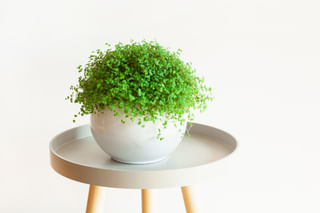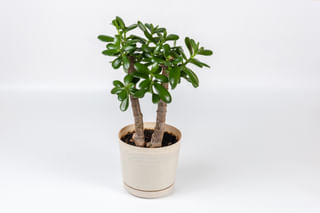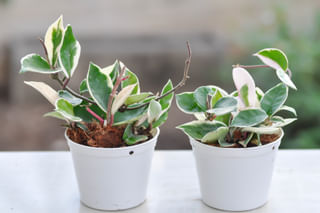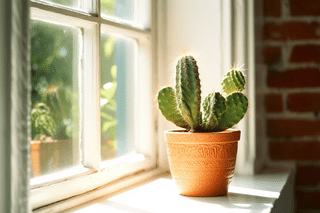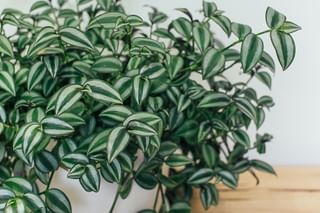10 Small houseplants to keep indoors
Discover 10 delightful small houseplants ideal for indoor spaces! I'm here to guide you through caring for these amazing houseplants. Find out how to take care of them with love and simple tips for lush growth. Let's go on this journey together and create a thriving indoor oasis!
Living in a small apartment doesn't mean you have to miss out on taking care of great houseplants. There are quite a few tiny plants that not only look great but are also easy to take care of. Even if you're a beginner and don't have a lot of space, you too can take care of some pretty amazing houseplants!
The plants on this list are amazing first plants for beginners, but also great options for those who simply don't have a lot of space left. All of these plants are low maintenance and resilient, making them ideal if you're a busy person or you're still learning to take care of plants.
Let's start to explore the best tiny houseplants together!
Baby's Tears plant
Don't be fooled by their size. Baby Tears plants are truly powerful! Their small, teardrop-shaped leaves gracefully come together to create a dense green carpet. If you'd like to give it a go and grow your own Baby Tears plant, they do wonderfully in environments with high humidity levels that get indirect light. Perfect for bathrooms and kitchens. Keep this little plant happy, and it'll give any space a great new texture.
There are several reasons you would want to add a Baby's Tears plant to your indoor garden, especially if you are a beginner.
Firstly, this plant is an excellent air purifier. It's known for its ability to filter and improve the quality of indoor air, making your apartment a much healthier place to live.
Secondly, despite its delicate appearance, the Baby Tears plant is relatively hardy. It can withstand fluctuations in temperature and lighting, making it a tough addition to your home, especially if you are still honing your plant-care skills.
Want to learn more about how to nurture this delightful little houseplant? Check out my in-depth guide at How do you take care of the Baby's tears plant (Soleirolia soleirolii)?. Dive deeper into understanding this plant's needs, and become a plant care expert in no time!
String of Pearls
This succulent plant is the crown jewel of your home! Strings of Pearls with their unique pearl-like foliage add a unique texture to your living spaces. And best of all, these plants stay relatively small, don't take a lot of time, and a very easy to take care of.
Simply place your String of Pearls in a bright spot, and keep its soil lightly moist. This adorable plant loves bright light, so make sure you provide it with plenty of indirect sunlight.
The best part about having a String of Pearls is that you can easily propagate it! Just snip off one or two strands and let them dry out for a few days. Then, plant them in a pot and watch as they grow into their own little plants!
If you're looking for something special to add to your apartment that looks amazing but doesn't require a lot of time or care, the String of Pearls plant is the perfect choice.
Want to know more about its care, propagation, or the best spots to place it in your apartment? Don't hesitate! Jump right in and explore our comprehensive guide at How to take care of a String of Pearls (Curio rowleyanus). Let me help you on your journey to becoming a pro at plant care.
Air Plant

Air Plants are pretty amazing! They have figured out how to thrive without needing soil. Just think of the excess pots and soil you'll be able to go without. The air provides all of the nutrients they need to thrive. All it takes is a bit of bright, indirect light and a thorough soaking session about once a week for them to be completely content. Talk about convenience, these ideal growing conditions require so little effort!
Air Plants are a fantastic choice for several reasons! Firstly, their unique soil-free lifestyle makes them a practical addition to your apartment, saving you from the mess and hassle of potting soil. This also means you can place them almost anywhere in your living space.
Secondly, they are extremely forgiving and low-maintenance. Even if you forget to water them once in a while, they are likely to survive, making them a perfect choice for beginners or those with busy schedules.
Eager to add these no-soil wonders to your indoor garden? Let's dive deeper into the world of Air Plants together! Discover more about their origin, various types, care routines, troubleshooting tips, and much more in my comprehensive guide. Just head over to Air plant care: a comprehensive guide for beginners and embark on your journey to becoming an Air Plant expert today!
Sedum Morganianum

Also known as Burro's Tail, this trailing succulent is something special! This Sedum doesn't just look unique, but it's also very easy to care for. All you need to do is make sure that it gets plenty of bright light and deep watering no more than once every 2 weeks.
The Sedum morganianum adds a touch of wonder and whimsy to any living space with its cascading tails of tiny, teardrop-shaped leaves. It's a great conversation starter and adds a unique look to your home.
The Sedum is incredibly tough, making it a great choice for beginners. It can withstand periods of neglect, and its water-storing leaves allow it to thrive even if you miss a watering or two. These features make it an ideal plant for those just starting on their plant care journey or for those with a busy lifestyle.
Curious to learn more about the captivating Sedum Morganianum and how to care for it? Don't miss out! Visit our article How to care for a Sedum morganianum for an in-depth look into this unique plant's care routine, propagation, and much more.
Jade plant
The Jade plant, also known as the money tree or Chinese rubber plant, is a favorite among all kinds of houseplant enthusiasts. These lovely succulent plants are extremely resilient and can tolerate a wide range of temperatures and lighting conditions. To keep it healthy, make sure to water it only when the soil has fully dried out and let it enjoy plenty of bright light.
The Jade plant is not just a great-looking houseplant but it also comes with some compelling benefits that make it a must-have. Firstly, it is considered a symbol of good luck in many cultures, which makes this plant an excellent gift for someone.
Secondly, Jade plants have air-purifying qualities, efficiently filtering indoor air and making your living space healthier. With these perks combined with their easy-care nature, the Jade plant happens to be an excellent choice for both plant-care beginners and enthusiasts.
Ready to dive deeper into the world of Jade plants? Visit my comprehensive guide at How to take care of a Jade Plant. From understanding its basic needs to mastering advanced care routines, I've got you covered.
Venus Flytrap
Another plant that stays quite small is a Venus Flytrap. This captivating carnivorous plant is more than fascinating to watch and it also helps provide natural pesticides against annoying flies. For optimum care of this unique plant, remember that Venus Flytraps enjoy bright light and damp soil. Their diet consists only of unsuspecting insects!
Venus Flytraps are a must-have for plant enthusiasts looking to diversify their indoor garden. Firstly, their insect-trapping mechanism adds some excitement, making them an interesting conversation starter when guests come over.
Secondly, these plants serve as a natural insect deterrent, keeping your living space free from flies and bugs. Owning a Venus Flytrap allows you to explore a wholly different plant-care routine while providing a unique addition to your indoor ecosystem.
Ready to dive into the exciting world of carnivorous houseplants? To get all the tips and tricks you need for caring for your Venus Flytrap, head over to my comprehensive guide at How do you take care of a Venus Flytrap?. Let's start this fascinating plant care journey together!
Hoya
Are you searching for an easy-care, slow growth, houseplant that's life going to win over your heart? Look no further! Hoya is the perfect pick for you! This houseplant prefers bright, indirect light and well-draining soil, so it's sure to make a great addition to any indoor environment.
Hoya plants are the epitome of charm and resilience, making them a preferred choice for many plant enthusiasts. First, their wax-like colorful flowers are not just visually appealing but also have a pleasant fragrance, adding a sensory delight to your home decor. They bloom in clusters, creating a captivating visual display that is sure to turn heads.
Second, Hoya plants are known for their toughness. They are drought-tolerant and can survive in less-than-ideal light conditions. This makes them a perfect match for beginners or those who may not have the time for a demanding plant care routine.
Ready to become a Hoya care master? Visit my in-depth guide at How to take care of a Hoya. This comprehensive guide is packed with all the information you need to keep your Hoya thriving.
Cacti
When it comes to choosing small indoor plants, everyone can find the perfect choice in a cactus. These hardy little plants require very minimal watering, just the occasional soak every couple of weeks, so they're perfect for busy individuals or those who tend to forget about caring for their plants.
To get the most out of your cactus, give it plenty of bright natural light every day so that it can grow to its full potential.
Cacti are not only aesthetically pleasing with their various shapes, sizes, and bloom colors, but they also bring a touch of the desert's rugged beauty straight into your home.
First, they can act as a natural humidifier, absorbing moisture from the environment and releasing it back into the air, creating a healthier indoor climate.
Secondly, cacti have a remarkably long lifespan, often outliving their plant parents. This long lifespan makes them a one-time investment for many houseplant enthusiasts.
Ready to introduce a Cacti into your home? Check out my detailed guide at How to take care of an indoor cactus to ensure your cactus not only survives but thrives.
Aloe Vera
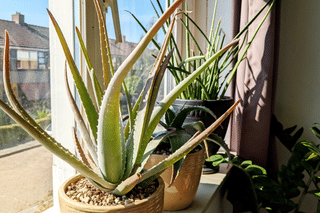
Easy to maintain with bright light and a good soak every couple of weeks, these plants are perfect for even the most absent-minded gardener.
Aloe Vera is a plant that's both great-looking and functional, making it a great choice for any indoor space. Firstly, its thick, succulent leaves are a sleek, modern touch that can complement any décor. Whether placed in a sunny kitchen window or on top of a work desk, it's going to draw attention.
Secondly, the Aloe Vera plant is famous for its medicinal properties. The gel inside the leaves can be used for a variety of home remedies, like soothing burns and moisturizing skin. This means having an Aloe Vera plant is like having a natural first-aid kit on your windowsill, which is beneficial for everyone.
Ready to harness the full potential of Aloe Vera in your home? Visit my comprehensive guide at How to care for an Aloe Vera. From understanding its basic needs to making use of its incredible medicinal properties, this guide will make sure your Aloe Vera thrives.
Tradescantia zebrina
Are you looking for a small trailing houseplant? Tradescantia zebrina might just be the one! This little gem is easy to care for, requiring bright indirect sunlight and occasional watering.
What makes this houseplant stand out from the rest are its unique leaves. It has a striking variegated pattern with purple, green, and white stripes, making it a great statement piece for any room in the house.
Tradescantia zebrina is also an air-purifying plant, able to absorb impurities from the environment. This means that having it indoors will not only improve your home's aesthetic but also its air quality.
Ready to make this attractive trailing houseplant a part of your home? Head over to my guide at How to care for a Tradescantia zebrina to get all the information you need for growing and caring for your Tradescantia zebrina.
Thank you for reading this post! I hope it helps you to keep your plants healthy and beautiful! If you're looking for more guides on specific plants, you can always request a plant guide to get a guide for the plant you have trouble with.
Test your plant care knowledge
Quiz completed!
Want to learn more? Sign up for my newsletter to receive free tips in your inbox!
Sign up now!
